Road trip: Wisconsin's concrete art
Love goofy roadside attractions? Here's where to find them, from Snow White to Sacagawea.
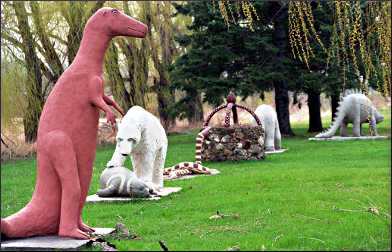
© Beth Gauper
In the early days of highway travel, some very ordinary folks toiled to enliven Wisconsin's roadsides.
Concrete dinosaurs appeared, and a muskie pulled by horses. King Neptune held court next to Snow White and her dwarves.
There was an ocean liner encrusted with glass, a Hindu temple and mythic figures from the American frontier — Sacagawea, Paul Bunyan, Kit Carson.
The neighbors of lumberjack Fred Smith thought he was a crackpot. But his 203 concrete-and-glass figures in northern Wisconsin draw thousands of visitors from around the world.
Along the Mississippi, a farmer who couldn't even put up a clothesline suddenly began to build lifelike dinosaurs and a beautifully arched concrete fence, with conical red posts tipped in gold.
In the south, a cheesemaker with a sly sense of humor adorned his yard with concrete fairy-tale figures and his house with glass "jewels."
For some reason, Wisconsin was a particularly fertile ground for self-taught artists, who had big imaginations but no commercial aspirations at all.
Most of these quirky "art environments" were crumbling when the Kohler Foundation in Sheboygan stepped in. It carefully restored them, then turned them over to local stewards.
Five of the sites are in the river valleys and coulees of southwest Wisconsin. A visit would make a fantastic road trip, taking pilgrims from the foot of the Mississippi River bluffs north of La Crosse to the far tip of the state, near Galena, Ill.
A sixth is in the north woods, near one of the best stretches of the Ice Age National Scenic Trail and Timms Hill, Wisconsin's highest point.
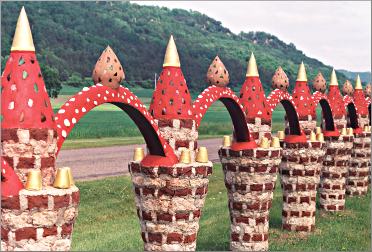
© Beth Gauper
From there, the trail heads south, to a grotto near Wisconsin Rapids, and then east to Sheboygan, home of the eighth site and the superb John Michael Kohler Arts Center.
These places are a good excuse to hit the road in any season. Here's what you'll see.
Prairie Moon Sculpture Garden, north of Fountain City
This site along the Mississippi River is the northernmost stop on a five-site tour of southwest Wisconsin.
In 1955, farmer Herman Rusch had retired and was keeping a museum of oddities in an old dance pavilion, where he often played his fiddle for visitors.
"He collected all kinds of really weird stuff," said conservator Ken Haeuser. "He had a tree where someone had left a scythe hanging in the crotch, and the tree grew around it; we still have that.
"But he got kind of bored with the museum, so he built a planter outside. Then he said that looked so lonely, so he built another one."
Rusch then built another three dozen concrete sculptures, including a Hindu temple, three dinosaurs, a crenellated stone watchtower and his arched fence, made by molding concrete over the iron wheels of old grain drills.
He also installed three sculptures by Halvor Landsverk, a farmer from Rushford, Minn., including a Norwegian hunter fighting off a bear.
Why?
"A lot of times, when people retire, they take a whole different direction," Haeuser says.
It's been called "dementia concretia." But Rusch called it "a good way to kill old-age boredom."
Prairie Moon Sculpture Garden and Museum is 11 miles south of Alma and three miles south of Cochrane. Look for Prairie Moon Road from Wisconsin 35.
From Fountain City, head east to the town of Cataract.
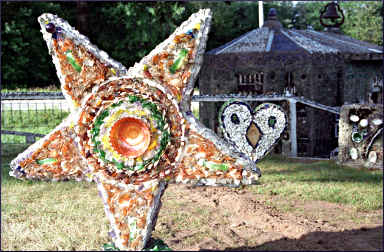
© Beth Gauper
Wegner Grotto, north of Sparta
Car dealer Paul Wegner had been retired for two years when, said grandson Don Wegner, he decided to "dress up the yard a little bit."
"He said, 'I don't like to hunt, I don't like to fish, I want to do something worthwhile with my time,' " Wegner said. He and his wife, Matilda — the boss of the operation, their grandson says — first built a glass church, inspired by the Dickeyville Grotto in the southwest corner of the state.
Then they built an American flag, a replica of their 50th-anniversary cake, a big white heart, a star and the Bremen ocean liner, all brilliantly adorned with bits of glass, crockery, porcelain and seashells.
The ship reminded them of the one on which they had emigrated from Germany, where Paul had apprenticed with a stonemason, Wegner said.
No one seemed to think their hobby unusual, he said.
"They were just conventional people," he said. "There was nothing hippie or yippie or artistic about them."
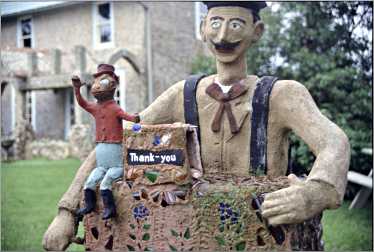
© Beth Gauper
The Paul and Matilda Wegner Grotto is nine miles north of Sparta off Wisconsin 71/27. The Monroe County Local History Room, on Main Street in Sparta, has an exhibit on the site.
From the Wegner Grotto, head south to Sparta, east on I-90, then south on Wisconsin 80 into coulee country.
Grandview, between Mineral Point and New Glarus
Austrian-born Nick Engelbert was a naval officer who jumped ship to become a gold prospector and, eventually, a dairy farmer. He loved his rural home: "If a man can't be happy on a little farm in Wisconsin, he hasn't the makings of happiness in his soul," he said.
But when he was in his 50s, around 1937, he fell off his roof and badly sprained his ankle. Unable to move around much, he retreated to a garage workshop.
"He hunkered in there all alone, and when he came out, he'd made a little clay thing with glass on it," said Ricky Rolfsmeyer, who lives nearby and oversees Grandview. "That's all she wrote. From that point on, he went nuts."
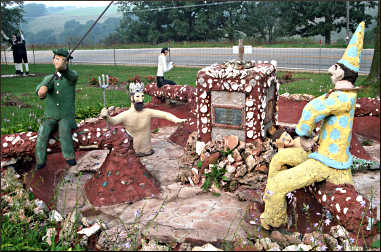
© Beth Gauper
He covered the family's clapboard house with concrete and glass, built more sculptures — an organ grinder, a Viking in a boat, Snow White and the Seven Dwarves, a stork with a baby, a Hapsburg castle and King Neptune in his fountain.
One sculpture, The Family Tree, depicted his four children as monkeys.
Engelbert also installed picnic tables for the gawkers.
"He didn't care that neighboring farmers said, 'You're goofier than hell to be building these statues.' He didn't care," Rolfsmeyer said.
Around 1951, after filling his yard, Engelbert switched to oil painting, and many of his works now hang in his former house.
Grandview is just west of Hollandale, 15 miles east of Mineral Point on Wisconsin 39.
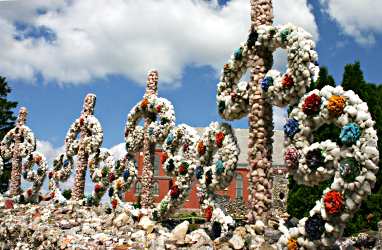
© Beth Gauper
From Hollandale, head southwest to Dickeyville.
Dickeyville Grotto, Dickeyville
This series of grottos and shrines of concrete, embellished with stones, glass, tile, crockery and shells, largely inspired the tradition of sculptural expression in Wisconsin and around the region.
It was created between 1925 and 1930 by a German-born priest named Mathias Wernerus at Holy Ghost Church in Dickeyville, in the extreme southwest corner of the state. Parishioners contributed treasures they'd scavenged from around the nation and helped with construction.
The Dickeyville Grotto is off U.S. 151, 12 miles north of Dubuque, Iowa. The gift shop is open daily from May through October.
The next site is in north-central Wisconsin, between Ladysmith and Tomahawk.
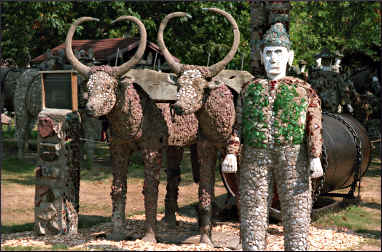
© Beth Gauper
Wisconsin Concrete Park, Phillips
Everyone around the town Phillips thought Fred Smith was unusual, to say the least. Of course, Fred Smith was unusual.
Between 1950 and 1964, the flamboyant retired lumberjack and tavern owner built 203 massive figures, wrapping lumber frameworks with mink wire and covering them with layers of concrete and a mosaic of broken beer bottles.
"Nobody knows why I made them, not even me," he said. "This work just came to me naturally . . . It's gotta be in ya to do it."
He made the man who delivered kerosene to local farmers in an ox-drawn wagon and Mabel the Milker, who milked by hand.
He built the whole Budweiser Clydesdale team and also Kit Carson, Paul Bunyan and Sacagawea, the Shoshone woman who led the explorers Lewis and Clark.
"She's the one who opened up the whole country," Smith said. "That's why I got so many Indians here. I like Indians because they're damn smart people."
In 1964, a stroke forced Smith into a rest home, but even there, he retained his joie de vivre: "I've been having a good time all my life!" he said. He died in 1976.
Wisconsin Concrete Park is just south of Phillips on Wisconsin 13, just north of U.S. 8.
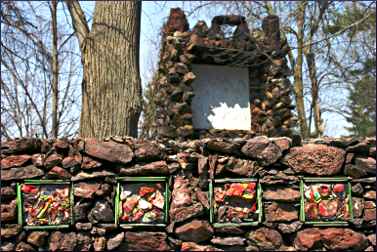
© Beth Gauper
Rudolph Grotto, near Wisconsin Rapids
While studying for the priesthood in Europe, Philip Wagner became ill. On a visit to the Grotto of Our Lady in Lourdes, France, in 1912, he prayed for health and promised to build a shrine to the Virgin Mary.
He recovered and collected ideas around Europe that he used when he was appointed pastor in Rudolph in 1917. He embellished the grounds of the church, now called St. Philip's, over many years.
Today, features include the Wonder Cave, a soldiers memorial, a playhouse and many rock bridges and pillar planters encrusted with bits of tile, abalone and glass.
Rudolph Grotto is eight miles north of Wisconsin Rapids off Wisconsin 34.
From Rudolph, head east to Green Bay and south along the shores of Lake Michigan.

© Beth Gauper
James Tellen Woodland Sculpture Garden, Sheboygan
James Tellen worked in a furniture factory in Sheboygan, painting decorative details. In 1942, in a hospital recovering from an illness, he was inspired by the concrete sculptures he could see in the churchyard across the street.
For the remaining 15 years of his life, he created concrete figures for the yard of his log summer cottage, often displaying the sly humor also seen at Nick Engelbert's Grandview.
In the hollow of a tree, below elves snickering in the branches, visitors look past a sign that reads, "If you look into this tree, the one you love best you will see," and into a mirror.
A piece inscribed "We whistle while we work" shows the Seven Dwarves in party mode, playing musical instruments and making wine. A tavern scene shows a woman scolding a man who has toppled onto his hands and knees, while four proper townsfolk look on.
Like Fred Smith, he liked to create pioneer scenes, including a young Abraham Lincoln splitting a log. His first work, the 65-foot-long "Fallen Log," is a free-form fence that features a bear, cubs and an Indian man, woman and child.
But Tellen also was deeply religious, and a boardwalk leads through the wooded back yard to a miniature basilica, a bust of Christ and a statue of the Virgin of Fatima.
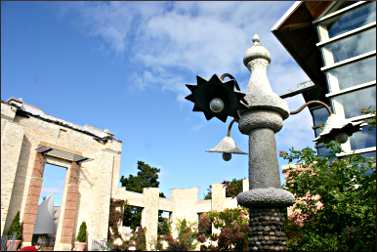
© Beth Gauper
Unlike Smith, Tellen had the encouragement of his friends and family, and his 1957 obituary in the Sheboygan Press called his sculpture environment "one of the finest exhibits of outdoor art in the state."
James Tellen Woodland Sculpture Garden is in a quiet neighborhood just south of Sheboygan. From Wisconsin 28, turn east on County Road EE, then go south on Evergreen Drive about 1 mile, just past Indian Mound Road.
John Michael Kohler Arts Center, Sheboygan
This lively arts center contains rotating exhibits and permanent collections, which include many pieces retrieved and restored from the southwest Minnesota farm town of St. James.
That's where blacksmith and cabinetmaker Carl Peterson created his Environmental Sculpture Garden of Nature from the turn of the century to 1940.
The pieces were removed and scattered, but Kohler curators were able to retrieve many from auction and restore them. Now, 15 of his large-scale pieces — light towers, fountains, castle-like birdbaths — can be viewed in the arts center's gardens.
John Michael Kohler Art Center is on New York Avenue on the edge of downtown Sheboygan, not far from the lake. It's open daily, and admission is free.
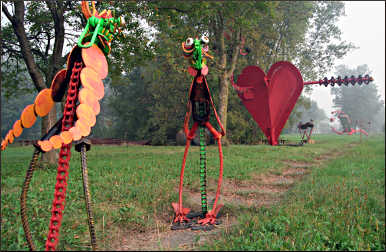
© Beth Gauper
Elsewhere around Wisconsin
In the Door County village of Baileys Harbor, a Polish immigrant loved birds. He'd spent his teen-age years hiding from Nazis in the woods, where the birds were his only friends.
Eventually, he filled his house and yard with more than 2,000 birdhouses, hand-carved cedar birds, angels, woodsmen, sailors, ships and woodland creatures.
Albert Zahn's Birds Park and house is privately owned and not open to the public. However, Kohler Art Center has a collection of his work, and occasionally, tours are available as part of fund-raising efforts.
In the posh Milwaukee suburb of Fox Point, on Lake Michigan, the sculpture-filled Mary Nohl site is owned by the Kohler Foundation, but neighbors have contested its use as a public attraction, and it cannot be seen.
It's on the National Register of Historic Places and in 2005 was listed by the Wisconsin Preservation Trust as one of the 10 most endangered properties in the state. Here's a lovely story about Nohl and her house, with many photos.
Along U.S. 12 south of Baraboo, wrecker and salvager Tom Every turned scrap parts into outlandish creatures, symbols and machines, including the Forevertron, a time and intergalactic travel contraption that apparently is the world's largest scrap-metal sculpture.
Dr. Evermor's Sculpture Park is seven miles south of Baraboo, next to Delaney Surplus. Nothing is labeled, but visitors are free to wander and look when the park is open; check for hours. A few times a year, it's open at night and lighted.
At M. Schettl Sales near Oshkosh, the overgrown grounds are a collection of salvaged oddities and statuary that include dragons, gargoyles, dinosaurs, circus animals, aliens and mermaids (though no guarantees, since they're for sale). The shop is at 5105 County Road S, south of Butte des Morts.
Just south of Holy Hill Basilica near Colgate, northwest of Milwaukee, the Paul Bobrowitz Spectacular Sculpture Garden features offbeat pieces as well as more sophisticated modern sculptures, some of them for sale, on a six-acre outdoor gallery. It's at N93W29174 Woodchuck Way.